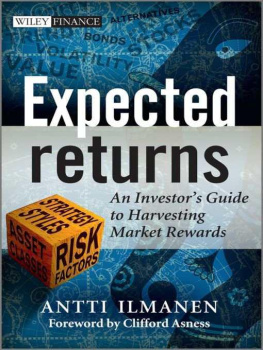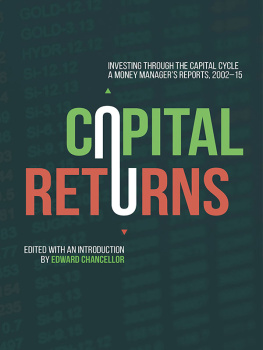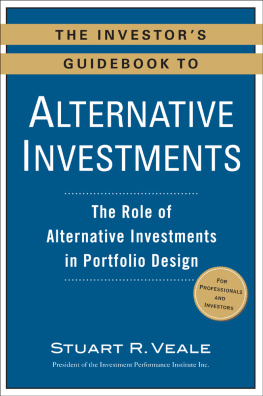Antti Ilmanen - Expected Returns: An Investors Guide to Harvesting Market Rewards
Here you can read online Antti Ilmanen - Expected Returns: An Investors Guide to Harvesting Market Rewards full text of the book (entire story) in english for free. Download pdf and epub, get meaning, cover and reviews about this ebook. year: 2011, publisher: Wiley, genre: Science / Business. Description of the work, (preface) as well as reviews are available. Best literature library LitArk.com created for fans of good reading and offers a wide selection of genres:
Romance novel
Science fiction
Adventure
Detective
Science
History
Home and family
Prose
Art
Politics
Computer
Non-fiction
Religion
Business
Children
Humor
Choose a favorite category and find really read worthwhile books. Enjoy immersion in the world of imagination, feel the emotions of the characters or learn something new for yourself, make an fascinating discovery.
- Book:Expected Returns: An Investors Guide to Harvesting Market Rewards
- Author:
- Publisher:Wiley
- Genre:
- Year:2011
- Rating:4 / 5
- Favourites:Add to favourites
- Your mark:
Expected Returns: An Investors Guide to Harvesting Market Rewards: summary, description and annotation
We offer to read an annotation, description, summary or preface (depends on what the author of the book "Expected Returns: An Investors Guide to Harvesting Market Rewards" wrote himself). If you haven't found the necessary information about the book — write in the comments, we will try to find it.
This is the best book on active management ever written - and it achieves that status without mentioning a single stock or bond by name. Anyone who performs the rigorous analysis Ilmanen describes - admittedly a neat trick, since the worlds most sophisticated investors struggle to do it successfully - will beat the market.
Laurence B. Siegel, Former Director of Research, The Ford Foundation
Antti Ilmanen shows the way forward for the investment management profession in this remarkable book. In a comprehensive and impressive way, he combines financial theory, historical performance data and forward-looking indicators, into a consistent framework for assessing expected returns and risk. His approach is both scientific and practical, based on decades of studies and his own trading experience. With a touch of personal wisdom and humility, Ilmanens book is a fascinating and educational journey into the future of investment management.
Knut N. Kjaer, Founding CEO of the Norwegian Government Pension Fund/NBIM and former president of RiskMetrics Group
Ilmanens wonderful book manages to be exquisitely readable while covering just about every aspect of the investment process. Filled with many, many fresh and useful insights. This volume deserves to be read and then kept close at hand - because it is sure to be needed again and again.
Martin L. Leibowitz, Managing Director, Morgan Stanley, and former CIO, TIAA-CREF
Job one for any investor is to estimate asset class returns. For the first time, Antti Ilmanen has assembled into one volume all of the tools necessary for this task: for the working money manager, a unique treasure trove of analytical techniques and empirical evidence; for the academic, a comprehensive guide to the relevant academic literature; and for the consultant, a blinding light with which to illuminate performance. Expected Returns is destined to occupy the front shelves of investment professionals around the world.
William J. Bernstein, author of The Intelligent Asset Allocator, The Birth of Plenty, and A Splendid Exchange, and co-principal of Efficient Frontier Advisors
Anttis synthesis of experience and theory has given us a book which fills a major gap in the literature on investing. Amazing, but true, this is the first book dedicated to the critical and challenging task of estimating how much we should expect to earn on our investments. This illuminating book, teaming with valuable insights that have never before been gathered under one roof, cannot fail to make the reader a more successful and discerning investor.
Victor Haghani, Associate Lecturer, London School of Economics, and former founding partner of LTCM
Ilmanen has written a thorough and detailed analysis of one of the central issues in investing.
Ken French, Heidt Professor of Finance, Dartmouth College
Investors decisions should be evidence based. Antti Ilmanen assembles a global body of evidence, and interprets it with insight. Read this book and you will improve your understanding of the future.
Elroy Dimson, Emeritus Professor of Finance, London Business School
If I could choose only one book on active management, I would choose Expected Returns. This book is extremely thorough and well researched, yet direct and to the point.
Roger G. Ibbotson, Professor in the Practice of Finance, Yale School of Management, and Chairman and CIO of Zebra Capital Management
Antti Ilmanen: author's other books
Who wrote Expected Returns: An Investors Guide to Harvesting Market Rewards? Find out the surname, the name of the author of the book and a list of all author's works by series.







